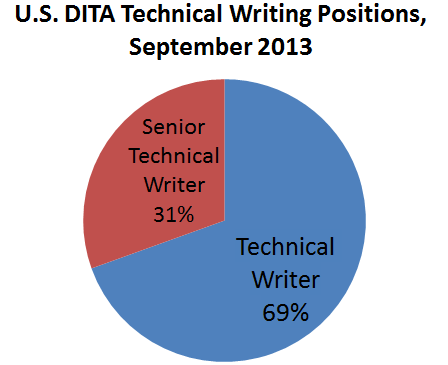
As mentioned in the previous article there is steady growth in the job market for technical writers with DITA experience. What’s interesting is that there are further signs that DITA usage within firms is maturing, indicating that DITA is now out of the “early adoption” phase.
The last time I did a DITA jobs survey back in February, I got the distinct impression that there were beginnings of a shift over from firms looking for Senior Technical Writers with considerable experience with DITA to “regular” Technical Writing positions. This would mean that there are more firms out there that have maturing DITA-based publication processes, and no longer have a critical need to hire people who can help them get that process off of the ground. For this last update I made a point of grabbing a copy of the job listings from Indeed.com, whose job titles could give me a sense as to whether this was the case.
It turns out my hunch was right:

To be fair things are rarely as clear-cut as this chart might suggest, as not all firms simply say they are seeking only “Technical Writers” or “Senior Technical Writers” with DITA experience. What I did is look at the job title for each position and the accompanying job description and classified other job titles into a “Senior” or “regular” mid-level Technical Writer category. So jobs listings looking for “Lead Technical Writer”, “Principle Technical Writer” or “Information Architect/Technical Writer” correspond roughly to the category of “Senior Technical Writer”, whereas “Technical Communicator”, “Technical Documentation Specialist” and “Support Technical Writer” fell into the mid-level “Technical Writer” category.
Proof in the Job Descriptions
This is backed-up with details from the job descriptions, as the mid-level positions are those where DITA processes are clearly mature:
- “[Has] worked with XML, XML authoring tools, DITA.”
- “Experience in structured authoring environment (DITA, XML, Frame Maker) is preferred.”
- “Experience with DITA XML and a Content Management System a plus.”
- “Knowledge of DITA and Arbortext.”
- “Experience using a XML-based editors and DITA for writing and delivering documentation.”
Contrast this to the job descriptions looking for more senior Technical Writers with DITA experience:
- “Develop expertise in DITA-based component content management system (Astoria Software) and content development tool (XMetaL).”
- “Writer will also convert legacy FrameMaker documents to DITA-XML format, and be able to author for both platforms.”
- “Documentation is being moved to DITA / XML and the team wants more ways to automate the process. For example, today we copy large tabular data from an Excel file into a FrameMaker or XML table.”
- “We are moving our documentation to DITA/XML and want more ways to automate the process.”
As you can see, there are distinct differences in how DITA is being used at these firms; those seeking mid-level Technical Writers already have a CMS or similar process in place, whereas those looking for more senior technical writers are more likely to be in the early stages of this same process.
The Tools They Use
Another thing that came out of my informal survey of Technical Writing jobs requiring DITA experience were the types of tools that those applying for these positions are expected to have experience with.
By far the most popular was Adobe FrameMaker. This should not come as a surprise as this product has been the mainstay of Technical Writing community for close to three decades now. This doesn’t tell the full story though, while there are many instances where FrameMaker (primarily version 9 and 10) is clearly the sole editor being used, the following descriptions involving the product were also typical:
- “Writer will also convert legacy FrameMaker documents to DITA-XML format, and be able to author for both platforms.”
- “XMetal (FrameMaker would be nice to have).”
- “Experience with Adobe FrameMaker or XML authoring tools such as oXygen.”
- “Use DITA/XMetaL and FrameMaker to author high quality documentation on schedule.”
In these cases FrameMaker is either playing a supplementary role or it is clear that legacy content based in an older version of FrameMaker is being converted over to DITA, often with an XML editor. Of those XML editors that are mentioned by name, the ones that come up the most are: Arbortext, oXygen and XMetaL. If you are a technical writer looking to get experience with DITA XML, these are the tools that you are expected to know in the workplace.
Many of the job descriptions mention use of a Content Management System, again the sign of a relatively mature DITA process. It is rare that specific CMSes are mentioned, but both SDL’s Trisoft and Ixiasoft’s DITA CMS get mentioned in a few of the job descriptions, and are likely in the lead in terms of DITA CMS deployments out there.
DITA use is clearly growing, and the evidence is that it has entered in a mature phase.
Next article: where are the DITA jobs in the U.S. and with what types of firms?

One thought on “DITA Takes Flight: Some Evidence of DITA Maturity”
Comments are closed.